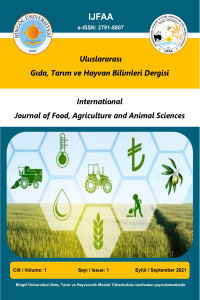Salvia syriaca L. Türünün Uçucu Yağ Kompozisyonu
Bu çalışmada, Bingöl’den toplanan Salvia syriaca L.’nın uçucu yağ kompozisyonu analiz edilmiştir. S. syriaca bitkisinin çiçekli örnekleri araziden toplanıp, su distilasyonu yöntemiyle uçucu yağları elde edilmişir. Bu taksonun uçucu yağları kalitatif ve kantitatif kompozisyonları GC-MS (Gaz Kromatografisi- Kütle Spektroskopisi) kullanılarak belirlenmiş ve incelenen uçucu yağ verimi %0.5 (v/w) olarak tespit edilmiştir. S. syriaca türünün uçucu yağının %98.5’ini oluşturan 37 bileşik tespit edilmiştir. S. syriaca’da temel bileşenler spathulenol (%24.96), borneol (%12.73), kamfen (%9.95) ve karyofillen oksit (%8.7) olarak belirlenmiştir. Sonuçlar kemotaksonomi ve doğal ürünler açısından tartışılmıştır.
Anahtar Kelimeler:
Uçucu yağ, GS-MS, Salvia syriaca L.
Essential Oil Composition of Salvia syriaca L.
In this study, the essential oil composition of Salvia syriaca L., collected from Bingöl was analyzed. Flowering samples of S. syriaca plant were collected from the field and essential oils were obtained by water distillation method. The qualitative and quantitative compositions of the essential oils of this taxon were determined using GC-MS (Gas Chromatography-Mass Spectroscopy) and the essential oil yield was determined as 0.5% (v/w). 37 compounds have been identified, constituting 98.5% of the essential oil of S. syriaca species. The main components in S. syriaca were determined as spathulenol (24.96%), borneol (12.73%), camphene (9.95%) and caryophyllene oxide (8.7%). The results were discussed in view of chemotaxonomy and natural products.
Keywords:
Essential oil, GS-MS, Salvia syriaca L.,
___
- Aslan, S., Akan, H., Pekmez, H., 2020. Yaslıca beldesi ve Arıkök mahallesi (Şanlıurfa)’nin etnobotanik açıdan araştırılması. Biological Diversity and Conservation, 13, 44-61.
- Baricevic, D. & Bartol, T., 2000. The Biological/ pharmacological Activity of the Salvia Genus. In: Kintzios, S.E., editor. Sage the Genus Salvia. Harwood Academic Publishers; Amsterdam, The Netherlands: 2000. pp. 143-184.
- Baser, K.H.C., Demirçakmak, B., Ermin, N., 2011. Essential Oil of Salvia syriaca L.. Journal of Essential Oil Research, 8. 105-106.
- Buchbauer, G. Jager, W. Jirovetz, L. Meyer, F. Dietrich, F. 1992. Effects of Valerian Root Oil, Borneol, Isoborneol, Bornyl acetate and Isobornyl acetate on the Motility of Laboratory Animals (mice) After Inhalation. Pharmazie, 47, 620−622.
- Cantrell, C.L., Klun, J.A., Bryson, C.T., Kobaisy, M., Duke, S.O., 2005. Isolation and identification of mosquito bite deterrent terpenoids from leaves of American (Callicarpa americana) and Japanese (Callicarpa japonica) beautyberry. J. Agr. Food Chem. 53, 5948-5953.
- Celep, F., Kahraman, A., Doğan, M., 2011. A new taxon of the genus Salvia (Lamiaceae) from Turkey. Plant Ecol Evol., 144, 111–114.
- Davis, P.H., 1982. Flora of Turkey and The East Aegeans Islands (Vol: 1-11). England: The Edinburg University Press. ISBN: 978-085-224-396-1.
- Flamini, G., Cioni, P.L., Morelli, I., Bader, A., 2005. Essential oils of the aerial parts of three Salvia species from Jordan: Salvia lanigera, spinosa and S. syriaca, Food chemistry, 100, 2. Guenther, E., 1949. The Essential Oils; Van Nostrand: New York, Vol. 2.
- Kamatou, G.P.P., Makunga, N.P., Ramogola, W.P.N., Viljoen, A.M., 2008. South African Salvia species: a review of biological activities and phytochemistry. Journal of Ethnopharmacology, 119: 667-672.
- Karakuş, M., Baydar, H. Erbaş, S., 2017. Tıbbi aAdaçayı (Salvia officinalis L.) populasyonundan geliştirilen klonların verim ve uçucu yağ özellikleri. Tarla Bitkileri Merkez Araştırma Enstitüsü Dergisi, 99-104.
- Karamian, R., Asadbegy, M., Pakazad R., 2014. Essential oil compositions, antioxidant and antibacterial activities of two salvia species (S. grossheimii Bioss. and S. syriaca L.) Growing in Iran. Journal of Essential Oil Bearing Plants, 17(2), 331-345.
- Knobloch, K., Pauli, A., Iberl, B., Wegand, H., Weis, N., 1989. Antibacterial and Antifungal Properties of Essential Oil Components. J. Essent. Oil Res., 119−128.
- Minhui L, Qianquan, L., Chunhong, Z., Na, Z., Zhanhu, C., Luqi, H., Peigen, X., 2013. An ethnopharmacological investigation of medicinal Salvia plants (Lamiaceae) in China. Acta Pharm Sin B, 3, 273–280.
- Orhan, I.E., Senol F.S., Ercetin T., Kahraman A., Celep F., Akaydin G., Sener B. and Dogan M., 2013. Assessment of anticholinesterase and antioxidant properties of selected sage (Salvia) species with their total phenol and flavonoid contents. Industrial Crops and Products. 41, 21-30.
- Şenol, F.S., Orhan. İ., Celep, F., Kahraman, A., Doğan, M., Yılmaz, G., Şener, B., 2010. Survey of 55 Turkish Salvia taxa for their acetylcholinesterase inhibitory and antioxidant activities. Food Chemistry, 120: 34-43.
- Tan, N., Satana, D., Sem, B., Tan, E., Altan, H. B., Demirci, B., et al., 2016. Antimycobacterial and antifungal activities of selected four Salvia species. Rec. Nat. Prod., 10, 593-603.
- Ulubelen, A., 2003. Cardioactive and antibacterial terpenoids from some Salvia species. Phytochemistry, 64: 395-399.
- Watson L. & M. J. Dallwitz, 1999. The families of flowering plants: descriptions, illustrations, identification, and information retrieval. New Orleans, LA: University of New Orleans.
- Yazdi, L., Hossein, G.M., Yazdani, D., Chehregai, A.K., 2005. Essential oils composition of leaves and flowers of Salvia syriaca L. and S. reuterana Boiss. from Borujerd-Iran. Journal of Medicinal Plants. 4. 15-21.
- Zhang, Q.L., Bingmei M.F., Zhang, J. Z., 2017. Borneol, a novel agent that improves central nervous system drug delivery by enhancing blood–brain barrier permeability, Drug Delivery, 24:1, 1037-1044.
- Ziaei, A., Ramezani, M., Wright, L., Paetz, C., Schneider, B., and Amirghofran, Z., 2011. Identification of spathulenol in Salvia mirzayanii and the immunomodulatory effects. Phytother. Res. 25, 557-–562.
- Zou, L., Jun-Zhi Lin, Hui-Ling Hu, Ying Wang, Ping Wang, Gang Zhao, Zhan-Guo Wang. 2012. Effect of borneol on intestinal absorption of muscone in rats. China journal of Chinese materia medica Nov;37(22):3490-3.
- Başlangıç: 2021
- Yayıncı: Bingöl Üniversitesi
Sayıdaki Diğer Makaleler
Çağlar KAYA, Tolga SARIYER, Esra ŞAHİN
H. A. Huda BASHIR, I. BUSHARA, İbrahim El İMAM
Arı Sütü Üretimi ve Bazı Biyoaktif Özellikleri
Büşra BELTEKİN, Nurullah DEMİR
Prof. Dr. Ergun BOZKURT’un Ardından
Salvia syriaca L. Türünün Uçucu Yağ Kompozisyonu
Nijerya'nın Yarı Kurak Bölgelerinde Ruminant Hayvanlarda Diyet Takviyesi
H. B. MOHAMMED, İbrahim El İMAM, I. R. MUHAMMAD, M. BABA, M. I. GHUDE
Sorbus sp. Cinsine Ait Bazı Türlerin Botanik ve Fitokimyasal Özellikleri Üzerine Bir Derleme
